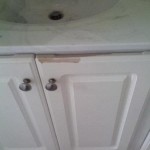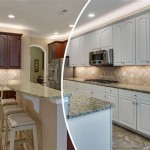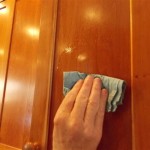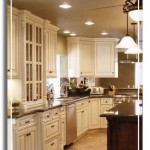Standard Thickness of Kitchen Cabinets
The kitchen is often considered the heart of a home, and kitchen cabinets are a crucial element in both its functionality and aesthetic appeal. Understanding the standard thicknesses used in cabinet construction is essential for homeowners planning a remodel, contractors designing a kitchen, and manufacturers producing cabinet components. Adherence to these standards ensures durability, structural integrity, and compatibility with hardware and installation methods.
The thickness of cabinet materials directly affects the cabinet's ability to withstand daily use, support countertops, and resist warping or sagging over time. While variations exist depending on the cabinet's location (base, wall, or tall), the type of material used (plywood, particleboard, MDF), and the manufacturer's specifications, certain thicknesses are widely accepted as industry benchmarks. Deviation from these standards can lead to structural weaknesses and compromised performance.
This article will examine the standard thicknesses for various components of kitchen cabinets, including boxes, doors, and shelves, and explore the factors that influence material choice and thickness selection. Understanding these standards allows for informed decision-making when selecting cabinets, ensuring they meet the demands of a busy kitchen environment and maintain their integrity for years to come.
Standard Thickness of Cabinet Boxes
The cabinet box, also known as the cabinet carcass, forms the primary structure of the cabinet. The sides, top, bottom, and back panels of the box are crucial for supporting the cabinet’s weight and providing a stable platform for shelves, drawers, and the countertop. Consequently, the thickness of the materials used in the cabinet box construction is paramount.
For cabinet boxes, the most common standard thickness is 1/2 inch (approximately 12.7 mm). This thickness is generally considered the minimum acceptable for adequate support and stability, particularly for wall cabinets that bear significant weight. However, many manufacturers, and particularly those producing higher-quality cabinets, opt for thicker materials to enhance durability.
A more robust and frequently preferred thickness for cabinet boxes is 3/4 inch (approximately 19 mm). This thicker material provides significantly greater strength and rigidity, reducing the likelihood of warping or sagging, especially in base cabinets that support heavy countertops and appliances. The 3/4-inch thickness also offers a more solid feel and improved screw-holding capabilities, which is important for attaching hardware and assembling the cabinet.
The selection of 1/2-inch or 3/4-inch thickness depends on several factors, including the quality of the materials used, the intended use of the cabinet (e.g., heavy-duty storage versus light-duty storage), and the budget. Lower-cost cabinets often utilize 1/2-inch material to minimize expenses, while higher-end cabinets typically feature 3/4-inch material for enhanced durability and longevity.
The back panel of the cabinet box also plays a crucial role in its structural integrity. While some budget-friendly cabinets may use thinner back panels, such as 1/4 inch (approximately 6.35 mm) hardboard or plywood, a thicker back panel is generally recommended for increased stability. A 1/2-inch or 3/4-inch back panel effectively prevents the cabinet from racking or distorting, particularly when it is fully loaded.
The choice of material also affects the required thickness. Plywood, being a layered and cross-grained wood product, offers greater strength than particleboard or MDF of the same thickness. Therefore, a 1/2-inch plywood cabinet box may be considered equivalent to a 3/4-inch particleboard or MDF cabinet box in terms of structural performance, although material compositions have their own advantages and drawbacks. Considerations such as moisture resistance, screw retention, and finishing also play a part in material and thickness selection.
In summary, while 1/2 inch is a common minimum standard for cabinet boxes, 3/4 inch is often preferred for enhanced strength and durability. The thickness of the back panel should also be considered, with thicker options providing greater stability. The choice between these thicknesses depends on the budget, material selection, and the intended use of the cabinets.
Standard Thickness of Cabinet Doors and Drawer Fronts
Cabinet doors and drawer fronts contribute significantly to the aesthetic appeal of a kitchen, but they also need to be durable enough to withstand frequent opening and closing. The standard thickness for these components is influenced by their design, material, and the desired level of robustness.
Typically, cabinet doors and drawer fronts are manufactured with a thickness of 3/4 inch (approximately 19 mm). This thickness provides sufficient rigidity to prevent warping and allows for secure attachment of hinges, handles, and other hardware. It also provides a substantial feel, contributing to the overall perception of quality.
However, variations in door thickness can occur depending on the style and construction method. For example, slab doors, which are flat and unadorned, are often made from 3/4-inch material to maintain a clean and uniform appearance. Raised panel doors, which feature a decorative center panel, may have a thicker overall profile due to the added depth of the panel and frame.
Inset cabinet doors, which sit flush with the cabinet frame, often require precise dimensions to ensure proper fit and function. While the overall thickness may still be around 3/4 inch, the thickness of the door's components, such as the stiles and rails, must be carefully considered to avoid interference with the frame.
The material used for cabinet doors and drawer fronts also impacts the required thickness. Solid wood doors are typically manufactured to a 3/4-inch thickness to prevent warping and provide a solid feel. MDF doors, which are often painted, may also be 3/4 inch thick, but they can be susceptible to sagging if they are too thin.
For smaller drawer fronts, a slightly thinner material, such as 5/8 inch (approximately 15.9 mm), may be used to reduce weight and cost. However, larger drawer fronts generally require a 3/4-inch thickness to maintain rigidity and prevent sagging, particularly when they are heavily loaded.
In summary, the standard thickness for cabinet doors and drawer fronts is typically 3/4 inch, but variations can occur depending on the style, construction method, and material used. Smaller drawer fronts may be slightly thinner, while larger doors and drawer fronts should maintain a 3/4-inch thickness for optimal durability and performance.
Standard Thickness of Cabinet Shelves
Cabinet shelves are responsible for supporting the weight of stored items, so their thickness must be sufficient to prevent sagging or bowing over time. The standard thickness for cabinet shelves varies depending on the span (the distance between supports), the material used, and the anticipated load.
For cabinets with a relatively short span, such as those less than 30 inches wide, a shelf thickness of 3/4 inch (approximately 19 mm) is generally considered adequate. This thickness provides sufficient strength to support most common kitchen items, such as dishes, glassware, and pantry staples.
However, for wider cabinets with longer spans, a thicker shelf is often necessary to prevent sagging. For example, shelves spanning 36 inches or more may require a thickness of 1 inch (approximately 25.4 mm) or even thicker, depending on the material used and the expected load.
The type of material used for the shelves also influences the required thickness. Solid wood shelves, particularly those made from hardwoods like oak or maple, can often support greater loads than particleboard or MDF shelves of the same thickness. Plywood shelves, with their layered construction, also offer superior strength compared to particleboard or MDF.
Particleboard and MDF shelves are more prone to sagging than solid wood or plywood shelves, so they generally require greater thickness to achieve comparable strength. Reinforcing measures, such as applying a solid wood edge banding or installing additional supports, can also help to prevent sagging in particleboard or MDF shelves.
Adjustable shelves, which are commonly used in kitchen cabinets, are typically supported by shelf pins inserted into pre-drilled holes in the cabinet sides. The thickness of the shelf is critical for ensuring that the shelf pins can adequately support the load without damaging the shelf material. Thinner shelves may be more prone to splitting or cracking around the shelf pin holes.
In summary, the standard thickness for cabinet shelves depends on the span, material, and anticipated load. For shorter spans, a 3/4-inch thickness is often sufficient, while longer spans may require thicker shelves. Solid wood and plywood shelves generally offer greater strength than particleboard or MDF shelves of the same thickness. Reinforcing measures can also be used to prevent sagging in weaker materials.
In conclusion, the standard thickness of kitchen cabinets is a critical factor in determining their durability, stability, and overall performance. By understanding these standards and considering the specific requirements of their kitchen, homeowners and contractors can make informed decisions when selecting cabinets, ensuring they meet the demands of a busy kitchen environment and maintain their integrity for years to come. Attention to these details results in a kitchen that is not only aesthetically pleasing but also functional and long-lasting.

N Standard Kitchen Dimensions Renomart

N Standard Kitchen Dimensions Renomart

Measure Your Kitchen Cabinets Before Designing The Layout

Kitchen Unit Sizes Cabinets Measurements Height Cabinet

Base Cabinet Size Chart Builders Surplus
Guide To Kitchen Cabinet Sizes And Dimensions

Kitchen Wall Cabinet Size Chart Builders Surplus Cabinets Dimensions Sizes

Helpful Kitchen Cabinet Dimensions Standard For Daily Use Engineering Feed

Kitchen Unit Door Combinations

Kitchen Cabinet Sizes What Are Standard Dimensions Of Cabinets
Related Posts








